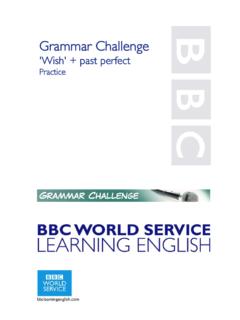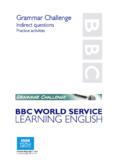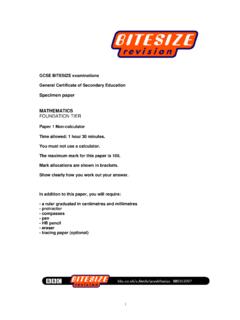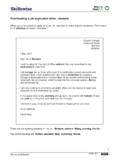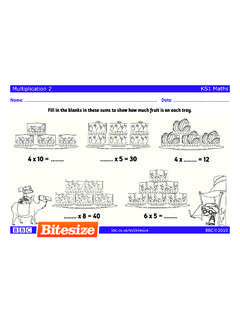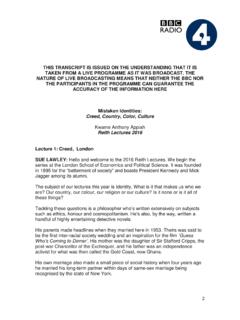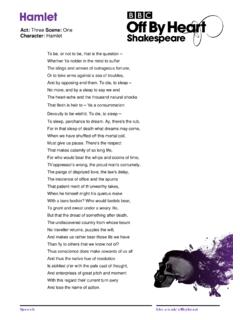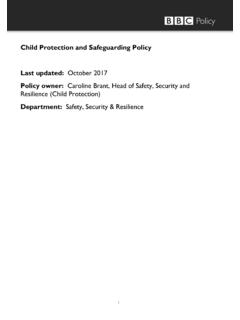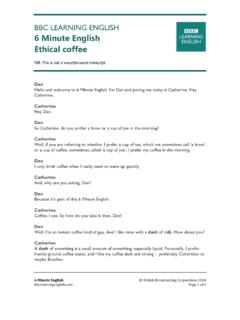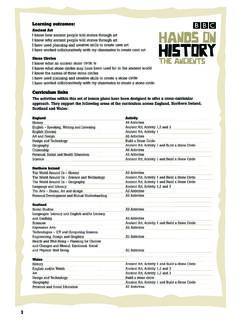Transcription of Review of the Research Literature on the Impact of ...
1 Review of the Research Literature on the Impact of multimedia Revision web materials Report for the BBC Manchester Metropolitan University Dr Nicola Whitton April 2009 2 Executive summary This document focuses on two questions: 1. What Literature exists regarding school students use of online curriculum support and revision resources? 2. What are the recommendations for a longer-term, in-depth piece of field Research in this area? In order to address these questions, a variety of Research databases, journals, reports, policy documents and web sites were reviewed to draw together Research evidence. Models of use Most children (84%) use the Internet daily or weekly and 90% of these use it for homework (Livingstone & Bober, 2004). There is evidence that students who use an online revision service perform better than those who do not (Osbourne, 2007; Kelley, 1999) and that computer use by children at home is linked to higher attainment (Punie et al, 2008).
2 However this could be accounted for by the extra time spent studying rather than the medium or be due to the class inequalities associated with home computer access. Interactive online resources can increase confidence and motivation (Valentine et al, 2005) but printed notes may be preferred to online ones (Macedo-Rouet et al, 2009). Students particularly like receiving instant feedback, the ability to record their progress (Krechowiecka, 2005), diagrams and simulations, and formative assessment (Livingston and Condie, 2004). Young people tend to use a variety of web sites depending on their purpose, but continually return to trusted sites (Cranmer, 2006). The degree to which students use revision sites is often greater than is expected by teachers (Livingston & Condie, 2004). Students will select which sites to use based on function and content first, then ease-of-use and appearance (Hughes et al, 2004) and site loyalty is determined by the quality of the system, information and service (Lin & Lee, 2006).
3 Students prefer to use ICT at home rather than school because of the levels of autonomy offered (Stevenson, 2008) and online revision sites support children to take increased responsibility for their own learning (Condie & Livingstone, 2007). Home use of ICT tends to be informal (Sefton-Green, 2004), with a single child on one computer, and activities where the learning outcomes are most obvious being less popular (Somekh et al, 2003). The degree of teacher engagement with the online resources and community is crucial for take up (Beanland, described in Krechowiecka, 2005) Online social networking is used by the majority of students and email and instant messaging is almost ubiquitous (Luckin et al, 2008) but most online communication takes place with friends that are known face-to-face (Livingstone & Bober, 2004). Online communities have the potential to foster interaction but can be undermined by school authority structures (Manchester Metropolitan University, 2003).
4 3 Media richness There is some evidence that a multimedia format can lead to higher attainment than a traditional format ( Vernadakis et al, 2008; Evans et al, 2008; Jones, 2008) but the Research in this areas is limited and inconclusive. There is also evidence that recognised benefits of multimedia use with adults do not always hold true for children (McTigue, 2009) and that increased media richness can lead to greater cognitive overhead and decreased learning (Acha, 2009). multimedia use in classroom setting can fail to meet its potential because of over-structuring of tasks and curriculum constraints (Hennessy et al, 2006). Learning from interactive multimedia is not necessarily correlated with fun or usability (Sim et al, 2006). Factors that influence engagement with interactive multimedia include levels of distraction and vividness of the media, the logic and instructions presented, and relevant prior knowledge possessed by the user (Rodrigues, 2007) and rich rather than superficial interaction is essential for engagement (Dunlap et al, 2007).
5 Learner diversity Technologies can support students with learning difficulties by providing a platform for training and rehearsal and by making learning available in new ways (Abbot, 2008). Interactive, media-rich web sites provide a forum for practice, feedback, clear progression structures, visualisation and explorative environments. Inequalities of access still exist in terms of class (Lee, 2008; Aslanidou & Menexes, 2008) with an estimated 30% of pupils in the UK having no access to a computer at home (Smith et al, 2008). The UK Governement has recently set up a Home Access Task Force to address issue of access (Becta, 2008) but this may still not address underlying inequalities such as support or attitudes (Selwyn & Facer, 2007). Online learning sites such as BBC bitesize were identified as key contact points for young people not in education, employment or training (Citizens Online and National Centre for Social Research , 2008).
6 There is evidence that online learning has a greater Impact on boys, students who are eligible for free school meals, and those for whom English was a second language (Osbourne, 2007). Recommendations for future Research There follow two recommendations for future Research and suggestions for ways in which these recommendations could be carried out: 1. A large-scale mixed-methods investigation into the learning and motivational effects of interactive multimedia on different types of learner. o Large scale experimental evaluations to compare different types of learning materials usage ( multimedia vs traditional, different degrees for interactivity) with different types of learner. o Online survey of learners to Review current practices in formal and informal settings. 4 o In-depth interviews (face-to-face and online) with learners, teachers and parents to examine current practice and use. o Data collection on technology use in informal settings using video diaries and camera-phones.
7 O Expert analysis of a sample of interactive multimedia web resources in terms of learning design and usability. o Analysis of user interaction in online community discussion forums. 2. A developmental investigation into the potential of integration and exploitation of elements of the web philosophy ( collaboration, sharing, production) into the design of online learning resources. o Ideas-generating focus groups with young people and other stakeholders, adopting a participatory design approach. o Initial prototype development (paper or wire frame) and user testing. o Development of recommendations for online learning design encompassing web principles. 5 Table of Contents Executive summary .. 2 1. 6 2. Literature Review 6 3. Findings from the Literature .. 7 Models of use .. 7 Media Learner diversity ..11 4. Recommendations for future work ..12 Appendix 1: Keywords and queries Appendix 2: Databases, web sites and journals used.
8 18 6 1. Introduction This report provides a Review of the Research Literature on the Impact and use of online multimedia revision sites. This document focuses on two key Research questions: 1. What Literature exists regarding school students use of online curriculum support and revision resources? 2. What are the recommendations for a longer-term, in-depth piece of field Research in this area? The first question is the predominant focus of this report and highlights three areas of the Research Literature : the current models of use of such sites; the effect of rich media web resources on learning; and the Impact of such sites on diverse learners. The Research described in this report aims to address such questions as whether and how young people s use of online resources differ from their use of traditional learning resources, how do users make decisions on which online resources to use (for example whether they stay with a single resource or pick-and-mix from multiple resources) and how exactly do young people use such sites.
9 Evidence will also be highlighted to show how effective online curriculum support is compared with offline media, and the Impact of online learning communities such as those that support the BBC Bitesize web materials . It aims to examine the Impact of rich media web resources, considering any effects of increasing interactivity and the use of multimedia on learning effectiveness, and whether the use of rich media and interactivity makes a difference to different types of learner. The report will also consider issues associated with learner diversity such as how BBC Bitesize and similar sites might support less academic learners, and whether gender differences exist in the use of online resources and, if so, what they are. The report is structured in four main sections; after this introduction there follows a brief description of the Research strategy employed. This is followed by a longer section that considers the Literature that addresses question 1, broken down into three sections that examine models of use, media richness and learner diversity.
10 The report finishes with a discussion of the key themes emerging from the Literature and presenting a number of recommendations for further Research . It is important to note that this report represents a small-scale desk- Research study, and can only aim to highlight the main pieces of evidence and Research work in this area rather than providing a comprehensive Review . It is also an area in which limited evidence currently exists in relation to some of the questions posed, and there is a clear need for further robust and in-depth studies in this area. 2. Literature Review strategy In order to address the Research questions described in the previous section, a variety of Research databases, journals, reports, policy documents and web sites were reviewed to draw together appropriate Research evidence to address the core question of what Literature exists in relation to the use of online multimedia revision sites such as that provided by BBC Bitesize.
